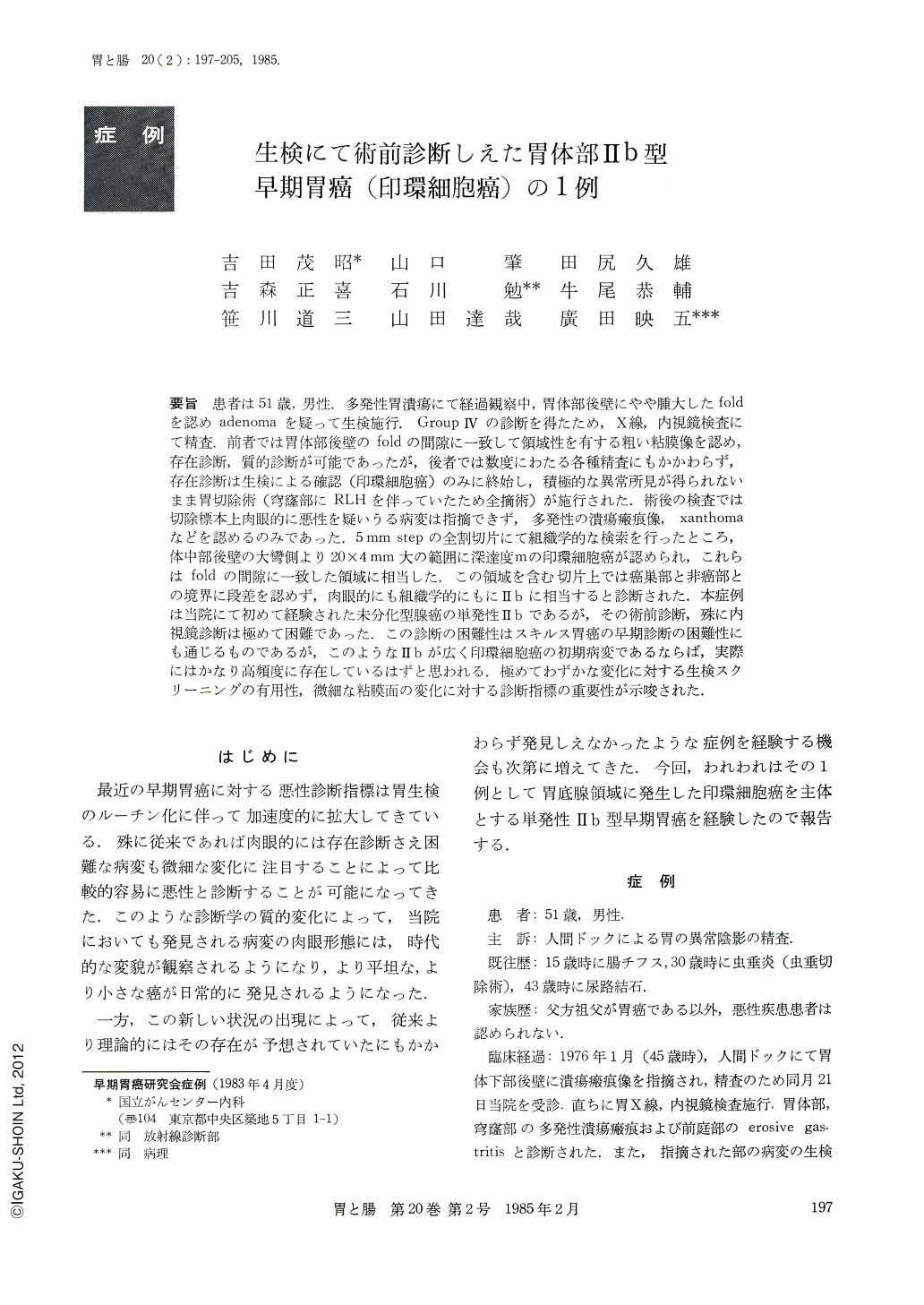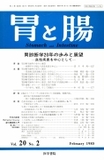Japanese
English
- 有料閲覧
- Abstract 文献概要
- 1ページ目 Look Inside
要旨 患者は51歳,男性.多発性胃潰瘍にて経過観察中,胃体部後壁にやや腫大したfoldを認めadenomaを疑って生検施行.Group Ⅳの診断を得たため,X線,内視鏡検査にて精査.前者では胃体部後壁のfoldの間隙に一致して領域性を有する粗い粘膜像を認め,存在診断,質的診断が可能であったが,後者では数度にわたる各種精査にもかかわらず,存在診断は生検による確認(印環細胞癌)のみに終始し,積極的な異常所見が得られないまま胃切除術(穹窿部にRLHを伴っていたため全摘術)が施行された.術後の検査では切除標本上肉眼的に悪性を疑いうる病変は指摘できず,多発性の潰瘍瘢痕像,xanthomaなどを認めるのみであった.5mm stepの全割切片にて組織学的な検索を行ったところ,体中部後壁の大彎側より20×4mm大の範囲に深達度mの印環細胞癌が認められ,これらはfoldの間隙に一致した領域に相当した.この領域を含む切片上では癌巣部と非癌部との境界に段差を認めず,肉眼的にも組織学的にもにⅡbに相当すると診断された.本症例は当院にて初めて経験された未分化型腺癌の単発性Ⅱbであるが,その術前診断,殊に内視鏡診断は極めて困難であった.この診断の困難性はスキルス胃癌の早期診断の困難性にも通じるものであるが,このようなⅡbが広く印環細胞癌の初期病変であるならば,実際にはかなり高頻度に存在しているはずと思われる.極めてわずかな変化に対する生検スクリーニングの有用性,微細な粘膜面の変化に対する診断指標の重要性が示唆された.
We have demonstrated a case of Ⅱb type of early gastric cancer detected preoperatively. Roentgenographically and endoscopically this case was followed up for more than six years under a diagnosis of multiple gastric ulcer scars on the posterior wall of the lower body and the fornix, when the biopsy specimens from the small and faint elevation (a part of mucosal fold) on the posterior wall of the middle body histologically revealed its malignancy.
Total gastrectomy was performed because of undeniable histological diagnosis of reactive lymphoreticular hyperplasia in the biopsy specimens from the ulcerative lesion on the fornix. It was impossible to locate the position of cancerous lesion on the resected specimen, although histological examination revealed a signet-ring cell carcinoma, measuring 20×4 mm, within the mucosal layer of the posterior wall of the middle body. This was the exact area from which malignancy was revealed by biopsy. In addition, thickness of the cancerous lesion and that of surrounding non-cancerous mucosa were quite the same, histologically. According to these facts, macroscopic type was regarded as Ⅱb type of early gastric cancer.
At the final roentgenographic examination, double contrast technic had preoperatively revealed this lesion as a faint barium fleck between the mucosal folds on the middle body, apart from the ulcer scar which had been followed up for a long time. By close observation, slight irregularity could be detected on the margin and surface of this lesion. These findings were compatible with those observed in extremely superficial carcinoma.
On the other hand, endoscopic pictures could not reveal any of the suspicious findings of malignancy, although it had been initially detected by biopsy specimens obtained from a faint elevation on the posterior wall of the middle body. On the above area slight irregular erythematous change was only seen with glossy mucosal folds endoscopically.
After the retrospective comparison among histologic, macroscopic, roentgenographic and endoscopic appearance, invasive area of the carcinoma could be identified, as shown in Fig. 11. Most part of the lesion could be expressed in the double contrast picture, and also be taken in endoscopic pictures. It was, however, still difficult to make exact diagnosis of cancerous invasion even in a retrospective observation.
In conclusion, in roentgenographic or endoscopic diagnosis of Ⅱb type of early cancer located on the gastric body, malignant findings are detected not on the tip of converging folds but on the mucosal irregularity between the folds. To detect more cases of this type of lesion, close observation on the roentgenographic or endoscopic pictures of the gastric body taken under a well-inflated condition with enough amount of air is necessary. And the diagnosis for such lesions will be very important, because this kind of lesion may have the possibility of being an early lesion of scirrhous carcinoma of which prognosis is the poorest among all of the gastric carcinoma.

Copyright © 1985, Igaku-Shoin Ltd. All rights reserved.


